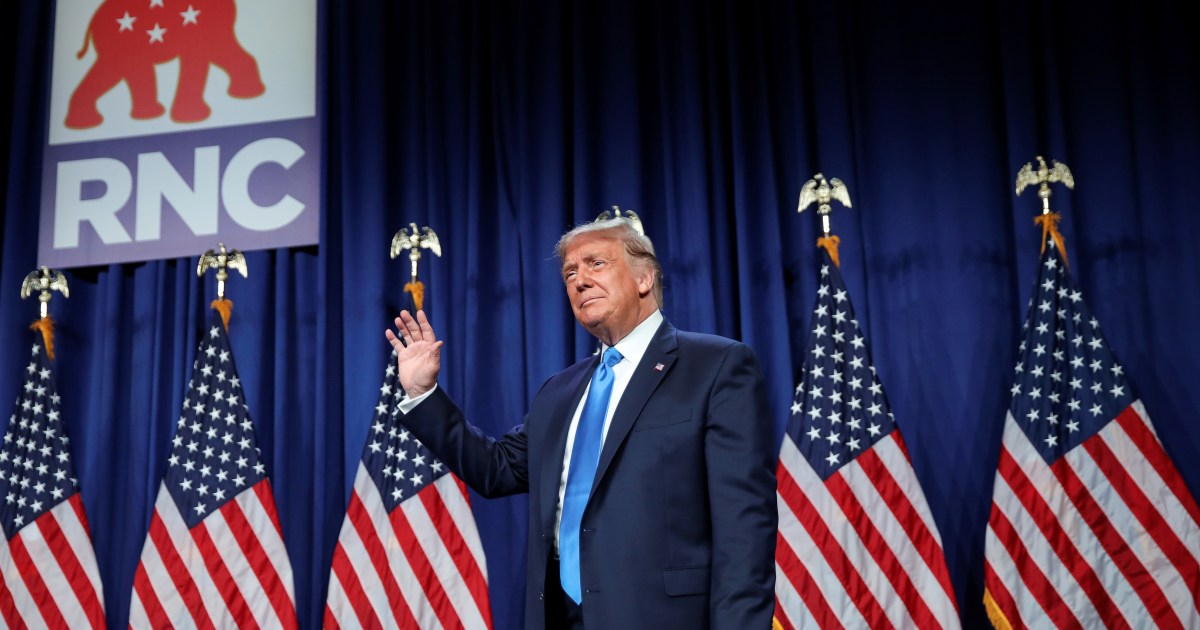After it was announced in Washington today that US President Donald Trump and his wife Melania had been infected with the new Corona virus;
Questions have been raised about the future of government in the United States if the condition of the White House resident worsens.
The US Constitution has clear provisions to ensure the continuity of government in the event of the death of the president or his inability to exercise his duties, and Amendment No. 25 of 1967 includes all the details of the transition process.
And prompted President Dwight Eisenhower's illness several times during his second term between 1956 and 1960 to consider a mechanism that would allow the president to not be vacant under any exceptional circumstances.
The United States is preparing for all the expected scenarios, which Al Jazeera Net summarizes in a question and answer format as follows:
What is the context for Constitutional Amendment No. 25?
During President Eisenhower's tenure, he suffered a heart attack and a mild stroke, which left an unprecedented state of uncertainty in the White House, amidst the tense periods of the Cold War with the Soviet Union.
Eisenhower and his deputy, Richard Nixon, agreed to an arrangement whereby Eisenhower would temporarily relinquish power if he was once again incapacitated, but he would determine himself when to restore his duties, and the agreement did not address what would happen in the event of total incapacity.
When John F. Kennedy succeeded him, anxiety over the power vacuum in the White House subsided. However, his assassination prompted the necessity to arrange the situation to deal with any urgent crises such as the assassination of the president or his inability to perform his duties.
What is the constitution's position on the succession of the president?
Article 2, Clauses 1 and 6 stipulate that the vice president assumes the “powers and duties” of the president in the event of the president’s “incapacitation”, but they do not say how it is determined that the president is unable to serve.
Hence the 25th Amendment to the Constitution, passed by Congress in 1965, and ratified in 1967 when Nevada became the 38th state to approve it.
Articles 3 and 4 of the amendment fill this constitutional gap: How to ensure that the nation has an executive head when the president is incapacitated.
What does Amendment 25 say in the US constitution?
The amendment deals with 3 scenarios, when the president decides that he is incapacitated, and later decides that he is able to return to office.
The president writes it and informs the speaker of the House of Representatives and the interim president of the Senate of his disability, and he notifies them again in writing when he is able to carry out his duties.
The Vice President will hold the Acting Chair during periods of incapacitation of the President.
Has Constitutional Amendment No. 25 ever been activated?
Yes, the department was called 3 times as follows:
The case of President Ronald Reagan undergoing surgery for a cancerous tumor in 1985, and Vice President George Bush Sr. became acting president for a temporary period.
And twice under President George W. Bush, in 2002 and 2007, when he was undergoing colonoscopy operations.
What about sudden president deficits?
Part 4 of the Amendment to the Constitution 25 deals with this part as follows: In such a case, the Vice President and the majority of the ministers inform the Speaker of the House of Representatives and the Interim President of the Senate that the President is unable to perform his duties, and the Vice President immediately assumes the position of Acting President, and the President resumes his duties "By written declaration."
What if the president objects to the result that he is unable to fulfill his duties?
Part IV of the amendment provides 25 answers that the vice president and the majority of ministers must declare again that the president is incapable of doing so, and they must do so in writing within 4 days.
After that, Congress must meet within 48 hours, and have 21 days to decide on the issue, and both chambers are required to obtain two-thirds of the votes to declare the president unable to perform his duties.
There is another path in Section IV of the 25th Constitutional Amendment to declare the president unable to serve.
The vice president might do so with “another body that Congress may provide for by law,” which is essentially an independent review board of doctors, psychotherapists, legal experts, and religious leaders.
What is the role of the US military in the transition process?
There is no role for the army, and the law stipulates referring to US courts and up to the Supreme Constitutional Court to resolve any dispute over the identity of the winning candidate in the event of a crisis in the counting or counting of votes, or if a candidate does not admit defeat.
The constitution did not give the army any role in the political transition process. Rather, the constitution specified the defense minister that he should be a civilian person. It also stripped the chief of staff of any political powers, and made the position weak with which the president could dismiss him with a tweet or phone call.
Who will succeed the president in the event of his death according to the US Constitution?
The constitution clearly defines the line of succession to the president in the event of his death or inability to carry out his duties.
The following table shows the succession ladder.
It is worth noting that in a few cases, he succeeded the vice president upon his death or abdicated, and the holder of the second position or beyond was never forced to arrange the ladder of succession.
The arrangement of the ladder of succession of the President
Vice President: Mike Pence
Speaker of the House of Representatives: Nancy Pelosi
Senator Acting Speaker: Chuck Gressley
Secretary of State: Mike Pompeo.

